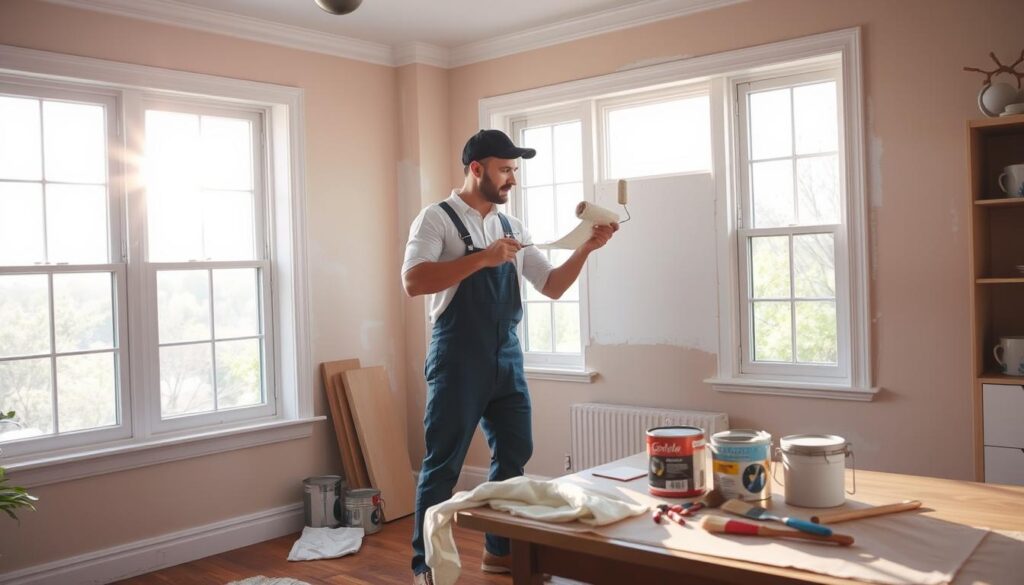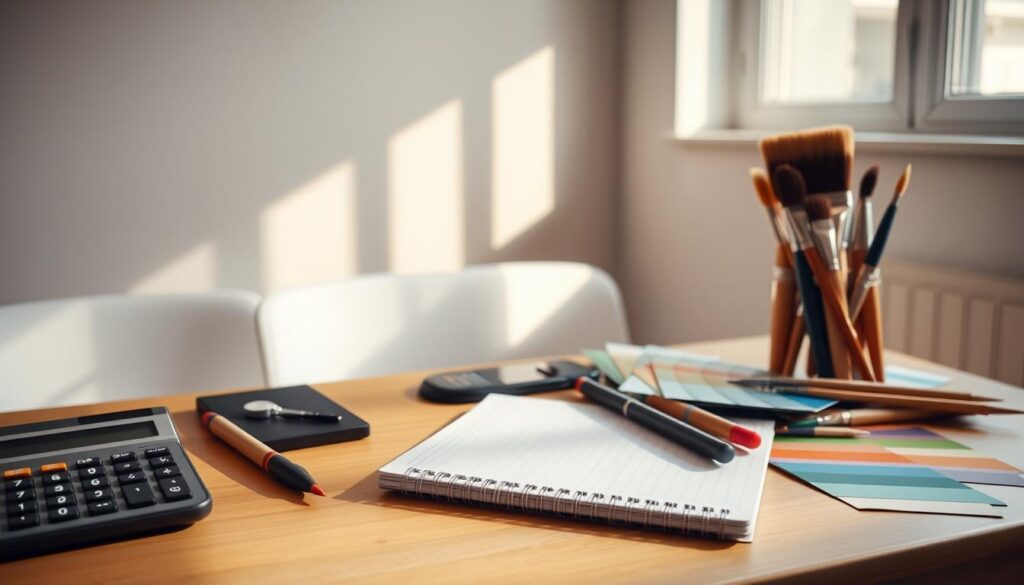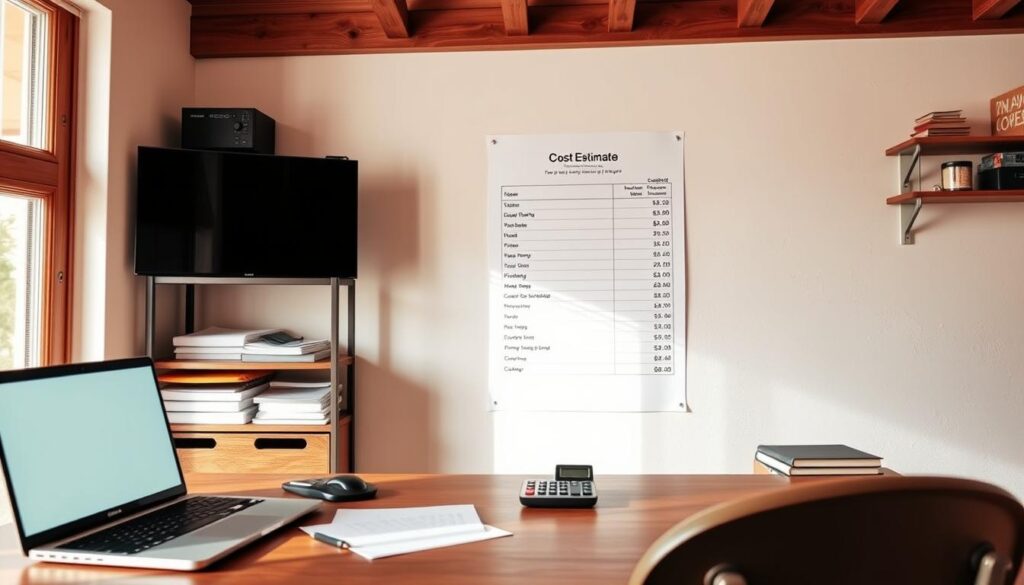Are you thinking of refreshing your home’s look? On average, homeowners spend $2,014 to paint their home’s interior. Costs can vary from $967 to $3,076, as shown by Angi and Home Advisor.
It’s important to know the average cost to paint a room and painting prices per square foot. This knowledge helps you plan your budget better. We’ll look at what affects these costs, guiding you in your painting project.
Key Takeaways
- Average interior painting cost is $2,014.
- Costs can range from $967 to $3,076.
- Factors like room size and paint quality affect costs.
- Understanding painting prices per square foot is essential.
- Getting multiple quotes can help you save money.
Understanding the Basics of Interior Painting Costs
The cost to paint your home’s interior can change a lot. This is because of different things like materials, labor, and more. These all add up to the final price you pay.
Let’s look at what affects these costs. Location is key, as professional house painting rates vary by area. This is because of different labor and material prices.
Factors Influencing Costs
Several important things decide how much painting your home’s interior will cost. These include:
- The size of the area to be painted
- The type of paint used
- Labor costs, which can change based on who you hire
- The job’s complexity, including prep work needed
Knowing these factors helps you guess the total cost. For example, using better paint might cost more upfront. But it could save you money later by needing fewer repaints.
Average Pricing by Region
Painting contractor pricing also depends on where you are. Cities usually have higher labor costs than rural areas. This affects your painting project’s total cost.
To get a better idea, look up average prices in your area. Check both material and labor costs. This helps you plan a budget for your painting project.
By understanding these basics and researching, you can make smart choices. This ensures you stay on budget and get the look you want.
Estimating Your Paint Requirements
Getting your paint right is crucial for a great painting job. You need to know the area’s square footage and the paint type.
Calculating Square Footage
Start by measuring each wall’s length and height. Multiply these to find one wall’s square footage. For example, a 12×8 wall is 96 square feet.
Do this for all walls and add them together. Remember to subtract the area of windows and doors. A good rule is to subtract 20 square feet for each door and 15 for each window.
Choosing the Right Paint Type
Choosing the right paint is as important as measuring the area. Different paints cover differently, and finish affects paint needs. For example, high-gloss covers more than flat.
Benjamin Moore says, “The paint type greatly affects your project’s look and durability.” Think about durability, washability, and color retention when picking paint.
Neutral colors like whites, grays, and beiges are popular for interior painting. They match many decorating styles. If you’re on a budget, get quotes from different painters to compare prices and services.
“The right paint can transform a room, making it feel fresher and more inviting.” –
By measuring right and picking the right paint, you’ll have a successful painting project. It will meet your needs and budget.
Labor Costs for Interior Painting
Labor costs are key when planning to paint your home’s interior. Knowing these costs helps you decide if you should hire pros or do it yourself.
Professional vs. DIY Painting
Deciding between hiring pros or painting yourself is a big choice. Pros ensure quality and save time but cost more. Rates vary by location and job complexity.
Going DIY saves on labor but takes a lot of time and effort. If inexperienced, you might end up with a bad finish, leading to extra costs.
Hourly Rates for Painters
Painter hourly rates differ by location, experience, and project needs. Expect to pay $25 to $50 an hour in the U.S. Urban areas and complex projects may cost more.
Getting quotes from several contractors is crucial. Ensure the quote includes prep work, coats, and cleanup. This helps compare prices accurately.
Understanding labor costs helps plan your painting project and budget. Whether hiring pros or doing it yourself, knowing the costs ensures a good outcome without overspending.
Additional Costs to Consider
To plan your interior painting project well, you need to think about more than just paint. Other costs can greatly affect your budget. Make sure to include these in your interior painting cost estimate from the start.
Primer and Preparation Materials
Getting your walls ready for paint is crucial. This means buying primer and other prep stuff. The price of primer changes based on quality and type. You might also need sandpaper, spackling, or other items for wall prep. These costs add up, so include them in your budget early on.
- Primer costs can range from $15 to $30 per gallon.
- Sandpaper and other prep materials cost between $20 to $50.
- Spackling compound and repair items can add $10 to $20 to your expenses.
Equipment Rental Fees
For big or complex painting jobs, renting special tools like sprayers might be needed. Equipment rental fees change based on the tool and how long you rent it. It’s important to add these costs to your budget to avoid surprises.
- Paint sprayers can be rented for $20 to $50 per day.
- Ladders and scaffolding rental fees range from $30 to $100 per day, depending on size and complexity.
Thinking about these extra costs helps homeowners plan better. This way, they can stay within their budget and get the painting job done right.
Choosing Paint Colors and Finishes
The paint color and finish you pick can change how your home looks and how much it costs. It’s key to think about both the color and the finish. They both affect the cost and the look of your home.
Impact on Overall Cost
The cost to paint your home’s inside can change a lot based on the paint color and finish. Some paints and finishes cost more because of their quality, the tech used, or the brand. For example, high-gloss finishes cost more than flat or matte ones because they need more advanced making.
Also, some colors, like those with certain undertones or needing extra coats, can raise the price. Going from a dark color to a light one might need more paint, which means a higher cost.
| Paint Finish | Description | Cost per Gallon |
|---|---|---|
| Flat/Matte | Non-reflective finish, good for hiding imperfections | $25-$35 |
| Eggshell | Slightly higher sheen than flat, easier to clean | $30-$40 |
| Satin | Soft sheen, durable, and easy to clean | $35-$45 |
| High-Gloss | Highly reflective, very durable | $45-$60 |
Popular Color Trends
Nowadays, people are leaning towards neutral and calming colors. These colors make rooms feel bigger and more peaceful. White, beige, and soft gray are favorites for their lasting appeal. Earthy tones and blues are also popular for adding warmth and coziness.
When picking a paint color, think about your home’s natural light and your furniture and decor. Talking to local interior painters near me can help find the best colors and finishes for your project. This way, you get the look you want without breaking the bank.
Cost Breakdown for Different Rooms
Knowing what each room needs for painting is key to figuring out the total cost. Rooms vary in size, fixtures, and prep work needed. This affects the painting cost.
Kitchens and Dining Areas
Kitchens and dining areas need more prep because of appliances and fixtures. This makes painting these rooms more expensive. You have to cover or remove these items for a clean finish.
The cost to paint a kitchen can be between $800 and $2,000. This depends on the kitchen’s size and the job’s complexity. Dining areas usually cost less, from $500 to $1,500.

Bedrooms and Living Spaces
Bedrooms and living spaces are simpler to paint because they have fewer fixtures. But, the room’s size and how many coats you need can still change the cost.
Painting a bedroom can cost between $400 and $1,200. Living rooms, being bigger, might cost $800 to $2,500.
Bathrooms and Hallways
Bathrooms are tricky because of moisture, which can shorten paint life. Hallways, though smaller, need careful planning for a smooth finish, even if they’re next to other painted rooms.
Bathrooms can cost $300 to $1,000 to paint. Hallways might cost $200 to $800, based on size and complexity.
| Room Type | Average Cost Range | Factors Affecting Cost |
|---|---|---|
| Kitchens | $800 – $2,000 | Fixtures, appliances, size |
| Dining Areas | $500 – $1,500 | Size, furniture, complexity |
| Bedrooms | $400 – $1,200 | Size, number of coats |
| Living Rooms | $800 – $2,500 | Size, furniture, complexity |
| Bathrooms | $300 – $1,000 | Moisture, fixtures, size |
| Hallways | $200 – $800 | Size, complexity, adjacent rooms |
The Importance of Surface Preparation
Getting your interior painting right starts with surface preparation. A well-prepared surface means a smooth finish and better paint adhesion. This makes the paint last longer.
Surface preparation includes fixing damaged areas, cleaning, and sometimes applying primer. These steps are vital for a professional finish. They’re even more important when looking for affordable home painting services.
Repairing Walls and Ceilings
Fixing walls and ceilings before painting is crucial. This means filling holes, sanding rough spots, and replacing damaged drywall. It makes the surface smooth and ready for paint.
Fixing walls and ceilings not only looks better but also saves paint. This can lower your project costs. It’s something to think about when figuring out how much to paint the interior of your home.
| Repair Task | Description | Benefit |
|---|---|---|
| Filling Holes/Cracks | Using spackling compound to fill in damaged areas. | Smooth surface for painting. |
| Sanding | Sanding down rough spots to create an even surface. | Improved paint adhesion. |
| Replacing Drywall | Replacing damaged drywall sections. | Ensures a durable surface. |
Cleaning and Priming Surfaces
Cleaning surfaces before painting is essential. Dirt, grease, and grime can ruin paint adhesion. We use a mild detergent and water to clean walls and ceilings well.
After cleaning, we often need to prime. This is true for stained or uneven surfaces. Primer creates a uniform base for paint. It ensures better coverage and a professional finish. This step is crucial when hiring professional house painting rates services.
By focusing on thorough surface preparation, we get a high-quality paint job. It looks great and lasts longer. Whether you’re painting yourself or hiring pros, understanding surface preparation is key to success.
Timing and Scheduling Your Project
The success of your interior painting project depends on careful timing and scheduling. Choosing the right time to paint can affect both cost and quality.

Best Seasons for Interior Painting
Spring and fall are the best seasons for painting indoors. The weather is mild, which helps paint dry faster. “Painting contractors often prefer these seasons because they offer ideal working conditions,” says a local painting contractor.
But, if you’re painting in a climate-controlled space, the season doesn’t matter as much. Also, think about your home’s humidity. High humidity can slow down paint drying. Using a dehumidifier can help keep your project on track.
How Long a Project Typically Takes
The time needed for interior painting varies. It depends on your home’s size, the number of rooms, and the job’s complexity. On average, a professional team can paint a standard home in 3 to 7 days.
- A single room might take a day or two to complete.
- Larger homes or those needing more prep work may take longer.
- It’s important to talk to local interior painters to get a precise estimate for your project.
When planning, remember to include time for prep work. This includes moving furniture, covering floors, and fixing walls. A well-prepared surface is essential for a great paint job. Knowing the painting contractor pricing helps with budgeting.
By planning your painting project well, you can get a top-quality finish. Whether it’s a single room or your whole house, getting an interior painting cost estimate from a trusted contractor is key. It helps you plan and budget well.
Budgeting for Your Painting Project
To keep your interior painting project affordable, making a detailed budget is crucial. You need to think about different costs like materials, labor, and unexpected expenses.
Creating a Realistic Budget
Understanding the costs is the first step in budgeting for your painting project. Start by figuring out how much area you’ll paint. This helps you know how much paint and materials you’ll need. The average cost to paint a room changes based on size, paint quality, and who does the work.
Here are the main things to include in your budget:
- Cost of paint and materials
- Labor costs (if hiring professionals)
- Equipment rental fees (if necessary)
- Primer and preparation materials
- Contingency fund for unexpected expenses
| Expense Category | Estimated Cost | Notes |
|---|---|---|
| Paint and Materials | $200-$500 | Depends on paint quality and quantity |
| Labor Costs | $500-$1,500 | Professional painting services |
| Equipment Rental | $50-$100 | For specialized equipment like ladders or sprayers |
Unexpected Expenses to Plan For
Even with a good plan, surprises can happen. It’s smart to have a backup fund for these surprises. Common surprises include:
- Repairing damaged walls or ceilings
- Additional coats of paint
- Specialized painting techniques or finishes
Planning for these surprises helps avoid going over budget. Set aside 10-15% of your budget for unexpected costs.
By following these steps and making a detailed budget, you can have a successful painting project. Whether you’re looking for an affordable home painting service or doing it yourself, a good budget makes the process easier.
Tips for Reducing Interior Painting Costs
There are ways to cut down on the cost of painting your home’s inside. You can save money by smart shopping and planning. It’s key to find ways to lower costs on both materials and labor.
Shopping for Discounts on Supplies
Look for deals at local hardware stores or online. This can help you save on painting supplies. Also, comparing prices per square foot can guide your choices.
Ways to Save on Labor Costs
Doing some tasks yourself can cut down on labor costs. This includes preparing surfaces or moving furniture. Finding local painters who charge less can also save you money.
With these tips, you can lower the cost of painting your home’s interior. You won’t have to sacrifice quality in the process.


